Fort Rosecrans National Cemetery
Introduction
Text-to-speech Audio
Fort Rosecrans National Cemetery is a federal military cemetery. It is located on the grounds of the former Army coastal artillery station Fort Rosecrans and is administered by the United States Department of Veterans Affairs. The cemetery overlooks San Diego Bay and the city from one side, and the Pacific Ocean on the other. Fort Rosecrans is named after William Starke Rosecrans, a Union general in the American Civil War. The cemetery is spread out over 77.5 acres (31.4 ha) located on both sides of Catalina Blvd.
Images
Fort Rosecrans National Cemetery with the Pacific Ocean and the USS Midway in the background
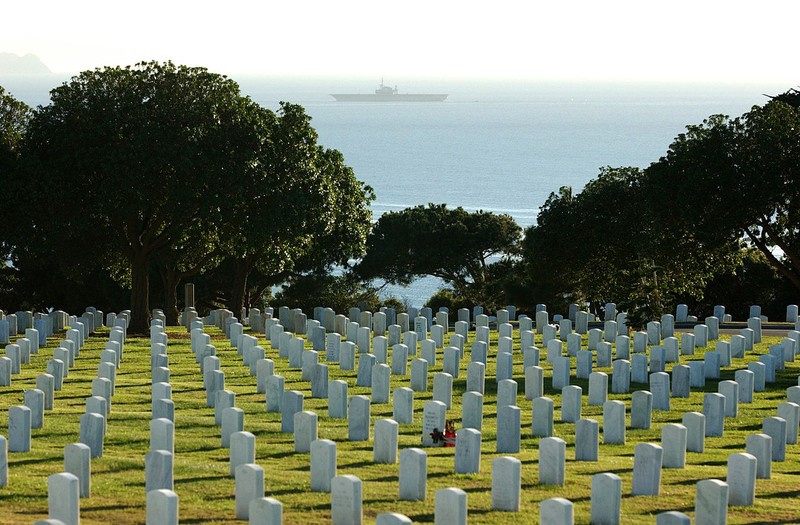
California State Parks monument to the cemetery
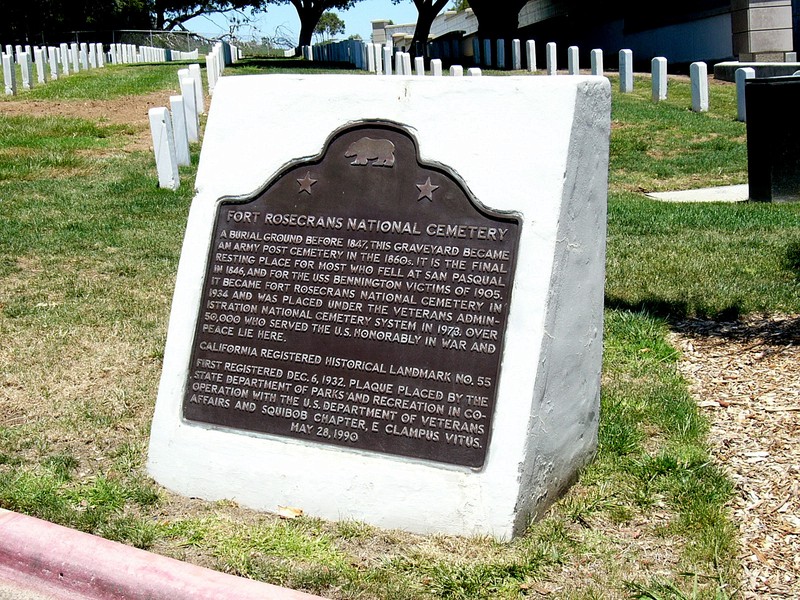
The USS Bennington monument soon after it was erected
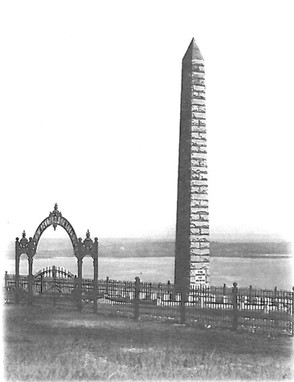
The Bennington monument as it looks today
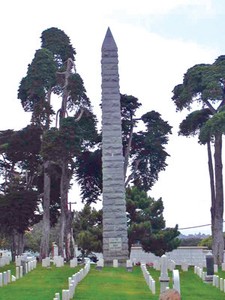
Mormon Battalion monument
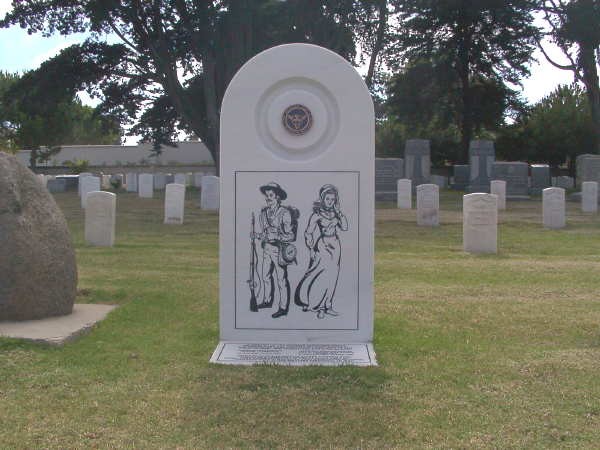
USS St. Lo monument
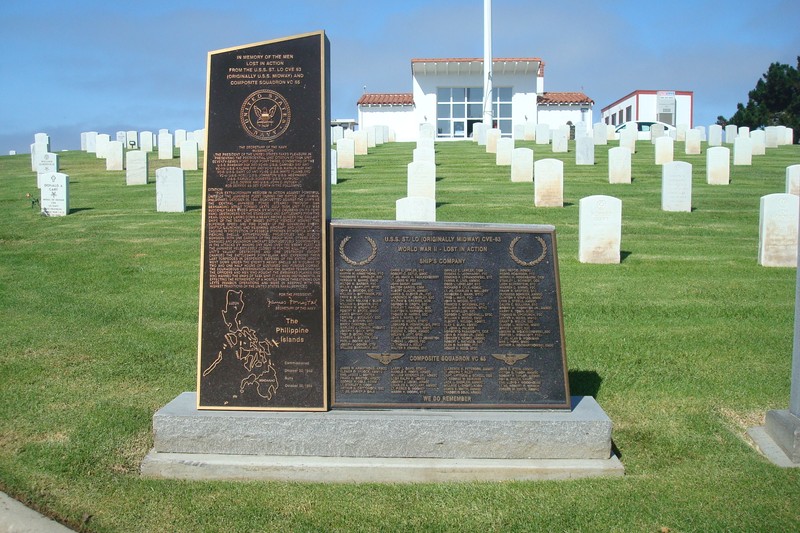
Entryway plaque
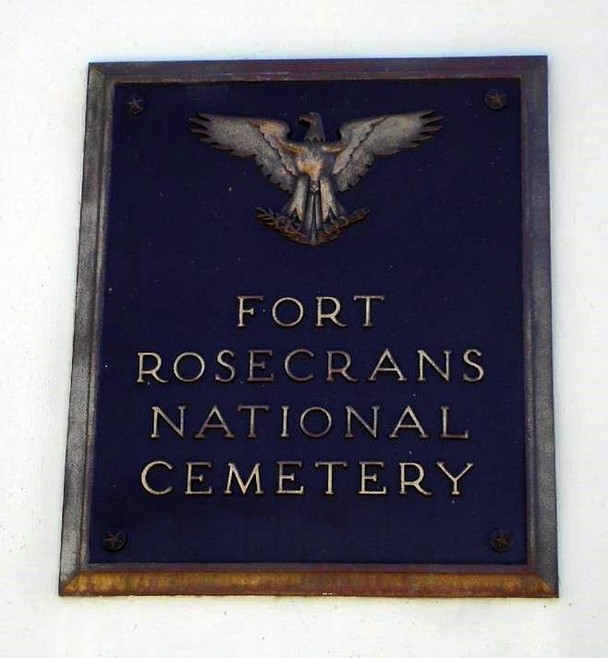
The Rostrum
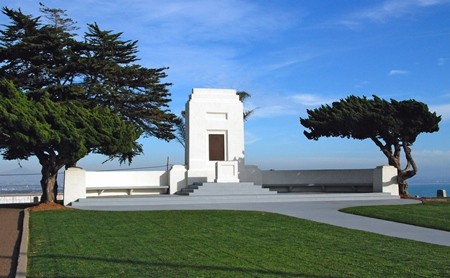
The cemetery with San Diego Bay and the city of San Diego in background
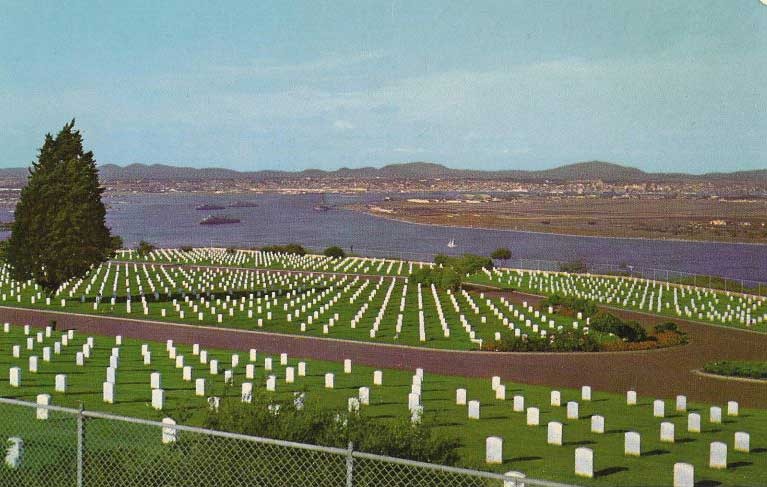
Gen. William Rosecrans, namesake of the fort-cemetery
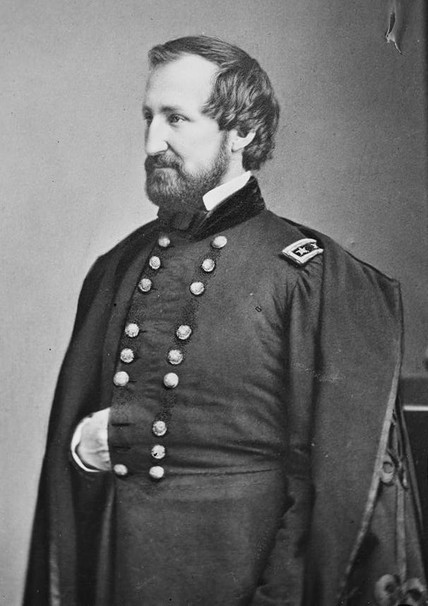
Backstory and Context
Text-to-speech Audio
Many of Fort Rosecrans interments date to the early years of the California Republic, including the remains of the casualties of the Battle of San Pasqual. Shortly after the United States declared war on Mexico in May 1846, Brigadier Stephen W. Kearny was tasked with conquering Mexico's northern provinces, New Mexico and California. While Kearny demonstrated his considerable gift for administrative command with his acquisition of the New Mexican territory, he faced a more difficult task in California. Expecting a show of force from the Mexican Californios, Kearny set out west from New Mexico. Upon reaching California, Kit Carson intercepted him and his men, who informed him the territory had been taken by American settlers in the Bear Flag Revolt. Kearny sent 200 of his men back to New Mexico with the news and continued forward with one-third of his force. Unfortunately, the success of the revolt had been exaggerated and, before reaching their destination, Kearny and his men encountered a group of Californios intent on keeping more U.S. troops out of their homeland.
In the subsequent Battle of San Pasqual, 19 of Kearny's men and an untold number of Californios lost their lives. Initially, the dead were buried where they fell, but by 1874 the remains had been removed to the San Diego Military Reservation. Eight years later, the bodies were again reinterred at what is now Fort Rosecrans National Cemetery. In 1922, the San Diego chapter of the Native Sons and Daughters of the Golden West had a large boulder brought from the battlefield and placed at the gravesite with a plaque affixed that lists the names of the dead.
Another notable monument in Fort Rosecrans National Cemetery is the USS Bennington Monument which commemorates the deaths of 62 sailors in a boiler explosion aboard USS Bennington (PG-4). The Bennington, which had just returned from maneuvers in the Pacific, was anchored in San Diego Harbor. On July 21, 1905, the crew was ordered to depart in search for USS Wyoming (BM-10), which had lost a propeller at sea. At approximately 10:30 a.m., an explosion in the boiler room ripped through the ship, killing or wounding the majority of the crew. Two days later the remains of soldiers and sailors were brought to the post cemetery and interred in an area known as Bennington Plot.
At one time, the cemetery was called the Bennington Nation Cemetery, but in 1934 was named the Fort Rosecrans National Cemetery. Fort Rosecrans became a National Cemetery on October 5, 1934. The decision to make the post cemetery part of the national system came, in part, due to changes in legislation that greatly increased the number of persons eligible for burial in a national cemetery. Grave space in San Francisco National Cemetery then grew increasingly limited. In addition, southern California was experiencing a phenomenal population growth during this period, and there was a definitive need for more burial sites.
All available space for casketed remains at Fort Rosecrans was exhausted in the late 1960s, but cremated remains continued to be accepted. The recent addition of extensive columnbaria, in place of old chain-link fencing has allowed the interment of thousands of additional World War II veterans there. Once Fort Rosecrans National Cemetery has reached maximum occupancy the cemetery will be turned over to the National Park System and the grounds will be maintained by park employees.
In 1973, Fort Rosecrans National Cemetery was placed under the control of the Veterans Administration. In May 2014, the cemetery had assigned all remaining spaces available; new burials will occur at Miramar National Cemetery.[6] It was listed on the National Register of Historic Places in 2016.
Today, the Fort Rosecrans Memorial Day celebration is the largest Memorial Day festivity in San Diego. The Fort Rosecrans Memorial Day Committee consists of war veterans' organizations, their auxiliaries, and patriotic groups.
Fort Rosecrans National Cemetery has several war memorials, including:
-The granite and bronze memorial to the USS Wasp (CV-7) commemorates the members of the ship's company who were lost when their ship was sunk during the Battle of Guadalcanal on September 15, 1942.
-The San Diego chapter of the Native Sons and Daughters of the Golden West installed the San Pasqual monument in 1922 to honor those soldiers who lost their lives in the 1846 Battle of San Pasqual during the Mexican-American War. The monument is composed of a stone boulder with a bronze plaque mounted on it.
The USS Bennington Monument is a 75-foot granite obelisk dedicated to the men who lost their lives on that ship in San Diego Harbor on July 21, 1905. The monument was dedicated on January 7, 1908.
-USS Bennington Monument
-The USS Ommaney Bay (CVE-79) monument is an etched granite memorial to the men lost in action when the ship was sunk on 4 January 1945.
-A monument dedicated to the Mormon Battalion was erected in 1998.
-The Patriots of America memorial was dedicated in 1999 by the California Society of the Order of the Founders and Patriots of America to honor all Americans who answered the call to arms.
The granite 3rd Infantry Division monument was dedicated to fallen comrades on February 16, 2002.
Several monuments have been erected in memory of the sailors lost in the Battle off Samar, October 25, 1944, a part of the Battle of Leyte Gulf (Philippines), and in subsequent battles of the Pacific:
-The USS St. Lo (CVE-63) and Composite Squadron VC-65 was erected in 1994.
-The USS Hoel (DD-533), USS Johnston (DD-557) and USS Samuel B. Roberts (DE-413) monument is a large granite memorial dedicated in 1995.
-The granite Taffy 3 monument was dedicated on October 24, 1996.
-The granite USS Gambier Bay (CVE-73) monument was dedicated on October 25, 1996. Family members and survivors donated the monument.
Sergeant Henry Frank Schroeder (Spanish American War), U.S. Army, Company L, 16th U.S. Infantry. Carig, Philippine Islands, September 14, 1900 (Section S, Grave 854)
Medal of Honor recipients (Dates included represent when Medal of Honor was given):
-Quartermaster Second Class Charles Francis Bishop (Mexican–American War), Seizure of Vera Cruz, U.S. Navy. USS Florida (BB-30), Mexico, April 21, 1914 (Section O, Grave 4562)
-Commander Willis W. Bradley (World War I), U.S. Navy. USS Pittsburgh (CA-4) (Section O, Grave 2925)
-Major Mason Carter (Indian War Campaign), 5th U.S. Infantry. Bear Paw Mountains, Montana, September 30, 1877 (Section PS-4, Grave 102)
-Staff Sergeant Peter S. Connor (Vietnam War), U.S. Marine Corps, Company F, 2nd Battalion, 3rd Marines, 3rd Marine Division (Reinforced). Quang Ngai Province, Republic of Vietnam, February 25, 1966 (Section A-E, Grave 1005)
-Boatswain's Mate William S. Cronan, U.S. Navy. USS Bennington (PG-4), San Diego, Calif., July 21, 1905 (Section T, Grave 534)
-Lieutenant Junior Grade Albert L. David (World War II), U.S. Navy. USS Pillsbury (DE-133), French West Africa, June 4, 1944 (Section OS, Grave 125-A)
-Corporal James L. Day (World War II), U.S. Marine Corps. Ryukyu Islands, Okinawa, May 14–17, 1945 (Section P, Grave 1748)
-Captain Jesse Farley Dyer (Mexican Campaign), U.S. Marine Corps. Vera Cruz, April 21, 1914 (Section P, Grave 1606)
-Vice Admiral Middleton S. Elliott (Mexican-American War), U.S. Navy. Vera Cruz, April 21–22, 1914 (Section P, Grave 2828)
-Captain Michael John Estocin (Vietnam War), U.S. Navy. Haiphong, North Vietnam, April 20 & 26, 1967 (Section MA, Grave 112)
-Lieutenant Junior Grade Donald A. Gary (World War II), U.S. Navy. USS Franklin (CV-13) off Japanese Home Islands near Kobe, Japan, March 19, 1945 (Section A-1, Grave 3-B)
-Seaman Ora Graves (World War I), U.S. Navy. USS Pittsburgh (CA-4), July 23, 1917 (Section W, Grave 1208)
-Second Lieutenant Herman H. Hanneken (Occupation of Haiti), U.S. Marine Corps. Grande Riviere, Republic of Haiti, October 21 & November 1, 1919 (Section C, Grave 166-D)
-Gunnery Sergeant Jimmie Earl Howard (Vietnam), U.S. Marine Corps, Company C, 1st Reconnaissance Battalion. Republic of Vietnam, June 16, 1966 (Section O, Grave 3759)
-Sergeant Ross L. Iams (Haitian Campaign), U.S. Marine Corps. USS Connecticut (BB-18), Fort Riviere, Republic of Haiti, November 17, 1915 (Section P, Grave 2930)
-Ensign Herbert Charpoit Jones (World War II), U.S. Navy. USS California (BB-44), December 7, 1941 (Section G, Grave 76)
-Master at Arms Michael A. Monsoor, (Iraq War), U.S. Navy SEAL. Ramadi, Iraq, September 29, 2006 (Section U, Grave 412-E)
-Coxswain John Edward Murphy (Spanish–American War), U.S. Navy. Santiago, Cuba, June 1898 (Section OS, Grave 363)
-Sergeant James Irsley Poynter (Korean War), U.S. Marine Corps. Sudong, Korea, Hill 532, November 4, 1950 (Section O, Grave 729)
-Sergeant Anund C. Roark (Vietnam War), U.S. Army. Kontum Province, Vietnam, May 16, 1968 (Section O, Grave 1855)
Sergeant Henry Frank Schroeder (Spanish American War), U.S. Army, Company L, 16th U.S. Infantry. Carig, Philippine Islands, September 14, 1900 (Section S, Grave 854)
-Lieutenant Commander Robert Semple (Mexican-American War), U.S. Navy. Vera Cruz, April 21, 1914 (Section OS-A, Grave 192)
-Lieutenant William Zuiderveld (Mexican-American War), U.S. Navy. Vera Cruz, April 21, 1914 (Section A-1, Grave 9-B)
Other burials:
-Commander Lloyd M. Bucher, U.S. Navy (1927–2004), Captain of the USS Pueblo (AGER-2), which was captured on January 23, 1968, by the North Koreans
-Margaret Landis Couper, (1890–1981) silent screen actress, wife of First Lieutenant James Hamilton Couper (1894–1953), U.S. Army (World War I)
-Master Chief Petty Officer of the Navy Thomas S. Crow, (1934–2008) fourth Master Chief Petty Officer of the Navy from 1979 to 1982.
-Captain Thomas Darden, U.S. Navy, 37th Governor of American Samoa
-Major Reuben H. Fleet, World War I aviator. The Reuben H. Fleet Space Theater and Science Center in San Diego was named after him
-Corporal Richard Garrick, U.S. Army, film director and actor. He served during the Spanish–American War
-Vice Admiral Edward Hanson, U.S. Navy, 28th Governor of American Samoa and World War I recipient of the Navy Cross.
-Major General Bruno Hochmuth, (1911–1967) U.S. Marine Corps, first Marine division commander to be killed in any war
-Lieutenant General Victor H. Krulak, (1913–2008) U.S. Marine Corps, served in World War II, Korea, and Vietnam in which he served as the Commanding General, Fleet Marine Force, Pacific. He was also the father of retired Marine General Charles Krulak, the 31st U.S. Marine Corps Commandant
-Vice Admiral William R. Munroe (1886–1966), United States Navy admiral who commanded ashore and afloat in the Atlantic theater during World War II
-General Joseph Henry Pendleton, (1860–1942) U.S. Marine Corps general. Marine Corps Base Camp Pendleton and Pendleton Street in Pacific Beach, San Diego were named after him.
-General Harry Schmidt (1886–1968), U.S. Marine Corps, Navy Cross, Commanded the 4th Marine Division and the Fifth Amphibious Corps, World War II
-Rear Admiral Thomas J. Senn, (1871–1947), U.S. Navy, Commander of USS North Dakota and also World War I recipient of the Navy Cross.
-General Holland Smith, (1884–1967) U.S. Marine Corps, commanded the Fleet Marine Force (FMF) in the Pacific during World War II and led the "island hopping" campaign in the central Pacific
-Lt. Colonel Laurence Stallings, U.S. Marine Corps, a playwright and screenwriter with over two dozen writing credits, including What Price Glory?
-PHMC Coy Watson, Jr., (1912–2009), U.S. Coast Guard, child actor
Sources
"Last space at Fort Rosecrans National Cemetery is claimed". KFMB. 7 May 2014.
"Fort Rosecrans National Cemetery". Office of Historic Preservation, California State Parks.
"Fort Rosecrans National Cemetery". Office of Historic Preservation, California State Parks.
